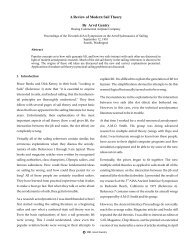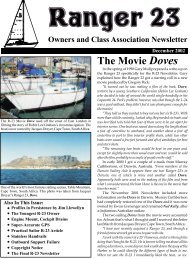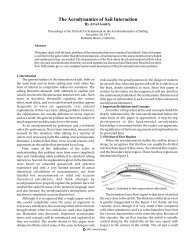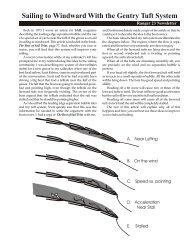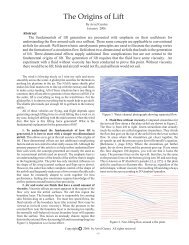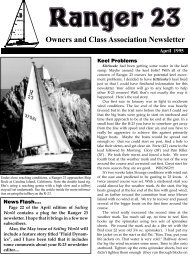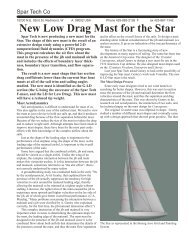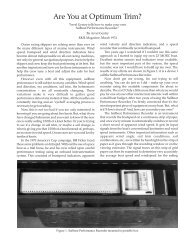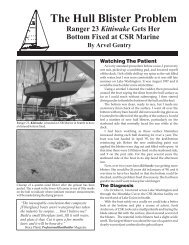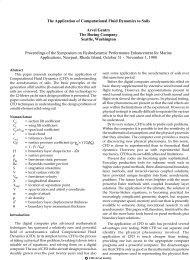How Sails Really Work.cdr - ArvelGentry.com
How Sails Really Work.cdr - ArvelGentry.com
How Sails Really Work.cdr - ArvelGentry.com
Create successful ePaper yourself
Turn your PDF publications into a flip-book with our unique Google optimized e-Paper software.
Arvel Gentry is a research specialist in transonic, supersonic<br />
and hypersonic vehicle aerodynamics at the McDonnell-Douglas<br />
<strong>com</strong>pany. He is also a successful ocean racing skipper and an<br />
amateur photographer.<br />
So you think that you know how sails work: the slot<br />
effect, backwinding, stalling, and all that stuff. You've<br />
learned these "facts" of sailing from books and from<br />
magazine articles by the experts. Well, read on. You are in<br />
for a few surprises.<br />
All the books give about the same explanation for how<br />
the main and jib work, and about slot effect. <strong>How</strong>ever, C.A.<br />
Marchaj in his book, Sailing Theory and Practice, states that<br />
"the interaction between sails is still a controversial subject<br />
and not fully understood." As a research aerodynamicist, I<br />
became very interested in this subject and set about<br />
conducting a study to, at last, resolve this problem.<br />
In my research, I made use of three important tools.<br />
First, the Analog Field Plotter, a device for accurately<br />
determining the streamlines about any airfoil shape.<br />
Second, a new sophisticated <strong>com</strong>puter program that is<br />
capable of calculating the pressures and air speeds on and<br />
about any airfoil <strong>com</strong>bination. And third, a water channel<br />
where the flow patterns about airfoil shapes, including<br />
separation effects, can be observed under controlled<br />
conditions and photographed. The results shown in this<br />
and the articles that follow are, therefore, based on wellproven<br />
aerodynamic analysis methods.<br />
My research has revealed the astounding fact that all<br />
the explanations in the sailing books on the interaction<br />
between the jib and main are wrong. In fact, if the air really<br />
went like many of these explanations say, then the<br />
resulting effects on the sails would be exactly the opposite<br />
of what is claimed!<br />
It will take a number of articles to present the <strong>com</strong>plete<br />
results of the research that has led to these conclusions.<br />
<strong>How</strong>ever, I like to think that each one of you will share<br />
with me a little of the excitement that I experienced when<br />
all the pieces of this puzzle started to fit together for the<br />
first time: the puzzle of how sails really work, how they<br />
influence each other, and most important, how to<br />
demonstrate clearly these effects. In this series, I will try to<br />
avoid unnecessary mathematics and technical terms; and<br />
though each article will deal with a particular aspect of the<br />
problem, a thorough understanding of it will depend<br />
upon the information contained in previous articles.<br />
To understand fully the interaction of a jib and a<br />
mainsail, we must have correct information in a number of<br />
areas: (1) we must know how the air flows about the jib and<br />
<strong>How</strong> <strong>Sails</strong> <strong>Really</strong> <strong>Work</strong><br />
“The airflow diagrams in the sailing books<br />
are wrong!”<br />
By Arvel Gentry<br />
SAIL Magazine, April 1973<br />
mainsail when they are used separately, (2) we must know<br />
where the air flows when the two sails are used together,<br />
December 1999<br />
(3) we must know how the resulting changes in airflow<br />
affect the pressures on both sides of the sails, and finally (4)<br />
we must know how the air very close to the surfaces of the<br />
sails (the boundary layer) is affected by the changes in<br />
airflow and the changes in surface pressures.<br />
Until recently, there has been no accurate way of<br />
obtaining all of this information. Actual test measurements<br />
are difficult to make, and when they are made, it is difficult<br />
to separate the effects of what happens in the airflow away<br />
from the sail surfaces from what happens in the boundarylayer<br />
air very close to the surface. The only approach in the<br />
past was to use "logical thinking" and "educated<br />
guesswork." <strong>How</strong>ever, the proper tools are now available<br />
to solve this problem and to provide a clear demonstration<br />
of the interaction effects.<br />
As the first step in understanding how the air flows<br />
around sails, one must be able to draw streamlines that<br />
show the paths that the air takes. The concept of a<br />
streamline is very simple and we need only to look briefly<br />
at the accurately drawn flow about a single sail (Fig.1) to<br />
get the basic idea. The streamlines tell the direction of the<br />
airflow at different points in the flow field about an airfoil.<br />
The airflow between two particular streamlines will<br />
always stay between the two streamlines. The stagnation<br />
streamline, marked (S) in Figure 1, is the streamline that<br />
separates the airflow that goes on one side of the airfoil<br />
(the lee or top side) from the airflow that goes on the other<br />
side (the windward or bottom side). The stagnation<br />
streamline leaving the trailing edge or leech of the airfoil<br />
divides the airflow <strong>com</strong>ing off the top of the airfoil from<br />
the air <strong>com</strong>ing off the bottom. The stagnation streamline is<br />
very important in understanding the flow about sails.<br />
Once a <strong>com</strong>plete set of streamlines is determined, we<br />
can make some very useful judgments as to how wind<br />
speed and pressure vary in the flow field about the airfoil.<br />
The relationship between speed and pressure is given by<br />
an equation called Bernoulli's equation. The Bernoulli<br />
equation shows how the pressure of the air and the speed<br />
of the air are directly tied together.<br />
Wherever airspeed increases in flowing around the<br />
sails, the pressure goes down. Where the airspeed slows<br />
down, the pressure will be found to increase. Wind, well<br />
out in front of the boat, may be blowing at a certain<br />
constant speed (relative to the boat). <strong>How</strong>ever, when the<br />
air gets closer to the boat, its speed and direction begin to<br />
change.
Ranger 23 Newsletter<br />
Sj<br />
If we look at the streamlines in Figure 1, we see that<br />
sometimes they get closer together and at other times they<br />
spread farther apart. It is quite obvious that when two<br />
streamlines get close together or close to the airfoil surface,<br />
the air will have to speed up to get through the smaller area<br />
and the air pressure will be lower. Where the streamlines<br />
get farther apart, the air slows down and the air pressure<br />
be<strong>com</strong>es greater.<br />
Now this is all quite simple, but it is important to note<br />
that before we can apply Bernoulli's equation, we must<br />
first know how the air flows about the airfoil. We must<br />
know where the streamlines go. The sailing literature is<br />
full of these types of drawings. Unfortunately, they are just<br />
that, drawings of where the particular author thinks the air<br />
goes.<br />
Figure 2 is typical of the airflow diagrams used in the<br />
books to explain the slot effect. There are a number of<br />
things wrong with this drawing, but I'll just mention the<br />
more obvious ones here. First, note that the stagnation<br />
streamline for the mainsail ( Sm) shows a slight amount of<br />
upwash (bending of the streamline leeward to meet the<br />
sail). The air knows that it is approaching the sail and it<br />
starts to change direction even before it gets to the sail.<br />
<strong>How</strong>ever, in Figure 2 the stagnation streamline drawn<br />
for the jib has no upwash at all. Apparently the wind<br />
knows that it is approaching the main but it doesn't know<br />
about the jib! That cannot be and this is the crux of the<br />
problem. The streamlines for both the jib and the main<br />
must show the proper effects of upwash. This cannot be<br />
determined by guesswork.<br />
<strong>How</strong>ever, that's not all that is wrong with Figure 2.<br />
Look at the streamlines marked A and B on each side of the<br />
stagnation streamline for the main. Out in front of the sail,<br />
the A and B streamlines are the same distance from the<br />
stagnation streamline so the airspeed is the same in both<br />
tubes of air; but by the time they reach the leech of the<br />
main, the lee streamline, A, is closer to the leech than is the<br />
windward streamline, B. We would, therefore, have highspeed,<br />
low-pressure air on the lee side of the leech<br />
stagnation streamline, and air with a lower speed and<br />
higher pressure on the windward side.<br />
high speed, low pressure<br />
low speed, high pressure<br />
Figure 1. Calculated flow stramlines about a jib.<br />
-2-<br />
Figure 2. Typical wrong slot-effect drawing.<br />
This situation cannot exist in the real flow about a sail.<br />
Instead, the entire flow about the sails would adjust itself<br />
so that the airspeed and pressures are the same on both<br />
sides just downstream of the leech. The streamlines should<br />
be equally spaced on both sides of the leech if they are<br />
equally spaced out in front of the sail.<br />
Another important requirement is that the spacing of<br />
streamlines right at the leech of the main must be the same<br />
as the spacing of these streamlines out in front of the sails.<br />
In other words, the airspeed at the leech of the main must<br />
be about the same as the freestream speed. I am assuming<br />
the sails are properly trimmed and have no flow<br />
separation. You will see the reasons for this leech recoveryspeed<br />
requirement in a later article (and also why it does<br />
not apply to the jib).<br />
Check some of the drawings in your own sailing books.<br />
See whether the streamlines at the leech are drawn<br />
properly. Also, check the stagnation streamlines leading to<br />
both the jib and main for upwash. None of the drawings I<br />
have seen has both the upwash and leech streamlines<br />
drawn properly. Since these erroneous streamline<br />
drawings do exist, it is easy to see why the venturi<br />
explanation of the slot effect has persisted for so long (that<br />
is, a wide stream of air seems to enter the slot between the<br />
sails and simply speed up as the slot gets smaller).<br />
Figure 3 shows a very accurately calculated set of<br />
streamlines about a main and jib <strong>com</strong>bination. Contrast it<br />
with Figure 2. Note that the stagnation streamline for the<br />
jib ( Sj)<br />
turns leeward as it approaches the luff and that it<br />
has more of this upwash than does the stagnation<br />
Sj
S J<br />
S m<br />
S J<br />
S m<br />
Figure 3. Streamlines about jib and main as calculated by potential flow program.<br />
Figure 4. Water channel photograph of flow about jib and mainsail airfoils.<br />
streamline for the main ( Sm). The stagnation streamlines<br />
for the jib and main actually spread farther apart as they<br />
approach the space between the luff of the jib and the<br />
mast.<br />
This is also substantiated in the water channel photo<br />
shown in Figure 4, and it is a very important point. It<br />
means that the air that is going to go in the slot between the<br />
two sails actually slows down as it approaches the sails. It<br />
slows down and only starts to speed back up as it<br />
approaches the leech of the jib.<br />
This means that the old explanation of the slot effect in<br />
the sailing books, the venturi principle, is actually wrong.<br />
The slot does not act as a giant venturi with the air<br />
approaching the sails and then just speeding up in a high<br />
speed jet of air in the space between the sails (as Figure 2<br />
erroneously indicates). Instead, the air first slows down<br />
and then is speeded back up in the slot.<br />
Now this may at first seem like a trivial difference, but it<br />
is a very significant factor. The stagnation streamlines for<br />
the main and jib show how the air approaches the sails,<br />
-3-<br />
how much air goes in the slot and, most important of all,<br />
how much air is caused to flow on the lee side of both the<br />
jib and main.<br />
In a later article, we will see that the final airspeed in the<br />
slot near the leech of the jib is only about what it would be<br />
if the jib were not even present and the flow on the main<br />
does not separate. Exactly why the air behaves in this<br />
manner and how it affects the boundary layer will be<br />
described in the <strong>com</strong>ing months.<br />
Addendum to <strong>How</strong> <strong>Sails</strong> <strong>Really</strong> <strong>Work</strong><br />
S J<br />
S m<br />
This article appeared in SAIL Magazine in April 1973. I<br />
had thought a lot about how my SAIL series might be<br />
viewed by the expert sailors. These people were the<br />
authors of sailing magazine articles and books that<br />
frequently said that “It is important for every serious sailor<br />
to understand the basics of how sails work.” Now here I<br />
was about to point out that much of what they were saying<br />
was wrong.
I was well prepared to argue the technical aspects of my<br />
findings (I had reviewed my work with several coworkers<br />
including my boss, the famous aerodynamicist,<br />
A.M.O. Smith). <strong>How</strong>ever, I was not prepared for the<br />
reaction that I got from Peter Barrett. Barrett had<br />
<strong>com</strong>peted in three Olympics and had won a silver in the<br />
Finn class and a gold with Lowell North in the Star. He<br />
wrote a monthly column called CARTE BLANCHE for<br />
Yacht Racing magazine and was quick to respond to my<br />
first article.<br />
CARTE BLANCHE, by Peter Barrett<br />
Yacht Racing Magazine, June 1973<br />
Science and Racing<br />
It is interesting to see how little the giant steps taken in<br />
expanding our reservoir of scientific knowledge have<br />
affected yacht racing. Although aerodynamics has very<br />
nearly be<strong>com</strong>e a science (40 years ago it was an art), and we<br />
have specialists like the author of a recent article in SAIL<br />
magazine, Arvel Gentry, who is a “a research specialist in<br />
transonic, supersonic, and hypersonic vehicle<br />
aerodynamics,” or like Jerry Milgram of MIT, whose<br />
Cascade sent the rule makers back to the drawing board,<br />
the sport of racing sailboats has in reality changed very<br />
little.<br />
Yacht design may have advanced . . . certainly recent<br />
designs win over older ones, but they are racing under the<br />
IOR, a new rule, and the frequently heard rationalization<br />
that “new designs are faster than old ones, and boats<br />
would have been out-designed had we remained with the<br />
CCA rule” ignores the 10-year reign of the Cal 40, or the fact<br />
that the hottest boat in MORC may well be the Cal 25, a<br />
design which must be nearly 10 years old. So one must<br />
wonder whether designers are really able to create yachts<br />
which get from here to there faster than their counterparts<br />
of a decade or two ago, given a range of wind and sea<br />
conditions.<br />
Also, if one looks at small boats, progress is<br />
questionable. The Snipe sails about as fast for its size and<br />
weight as any boat; although Lasers beat Sunfish in light<br />
and medium air, the reverse happens in a strong breeze;<br />
few if any modern designs can <strong>com</strong>pete with either the<br />
Star or Thistle in light air, and 110s are able to give the much<br />
more sophisticated Flying Dutchman fits in heavy air.<br />
Progress in sails and rigs is slow as well. The adoption of<br />
Dacron and aluminum have been real advances in speed<br />
and ease of maintenance, but improvements in the basic<br />
concept of a <strong>com</strong>plicated and sophisticated rig like a Star or<br />
Flying Dutchman have been few in the past several years.<br />
The primary reason for the perseverance of the status quo is<br />
the relatively high level of development attained many years<br />
ago, despite limited knowledge and primitive research tools. A<br />
Star or Snipe of the late 1930s was a pretty sophisticated windbending<br />
machine.<br />
Although I have been trained as an engineer,<br />
specializing in fluid mechanics, I find my reaction to<br />
exciting claims in the field of air or water flow is usually a<br />
-4-<br />
negative one. I wonder how the Federal Trade<br />
Commission can allow the advertisements for paints or<br />
bottom coatings which “improve speed five to 10 percent”.<br />
If any bottom treatment could consistently improve speed<br />
by two percent over a smooth fair untreated bottom, it<br />
would be on every racing sailboat in the world. Although<br />
Marchaj's book on the aerodynamics of sailing is far more<br />
detailed and accurate than Curry's, published in1925, I<br />
suspect that Curry's may do more for 95 percent of the<br />
world's yacht racers than Marchaj's. When I wrote an<br />
article 10 years ago viewing sails from a fluid momentum<br />
concept instead of a pressure-velocity relationship, I stated<br />
near the end that “the average racing skipper will probably<br />
not find many applications for sailing theory in its pure<br />
form.” I feel the same way today.<br />
The best sailors, in general, are not scientists. Paul<br />
Elvstrom, Bud Melges, Rodney Pattisson; these people<br />
attack sailboat racing physically and emotionally more<br />
than they do scientifically. Although Pattisson's FD rigs are<br />
as aerodynamically clean as any rigs in use on any boat<br />
today, it is a result of a <strong>com</strong>mitment to detail carried to the<br />
ultimate, and not any unique aerodynamic concepts. All of<br />
us know that windage and drag are bad, even if we were<br />
lucky in escaping high school science. Few of us practice<br />
our knowledge as thoroughly as Rodney.<br />
Another step in a long line of published material which<br />
serves more to provide fireside conversation than to win<br />
races appears, as mentioned above, as the first of a series in<br />
SAIL by Arvel Gentry. I confess to being interested,<br />
although skeptical, when I read the editor's <strong>com</strong>ment that<br />
“it is both disturbing and exciting to be told that all the<br />
books that describe how sails work are wrong . . .”. The<br />
article's subtitle continued the theme: “the airflow<br />
diagrams in the sailing books are wrong!” I was<br />
disappointed, but not surprised, to find that the sum total<br />
of the “astounding fact” in error in all the books is that the<br />
stagnation streamline for both jib and main is rarely drawn<br />
with enough upwash, and that the authors of material on<br />
the subject haven't thought it necessary to discuss the air<br />
flow on the windward side of the jib before reaching the<br />
mast, and particularly that the air isn't being accelerated in<br />
this region. Mr. Gentry promises more but I am willing to<br />
state categorically that future articles will do little if<br />
anything to improve directly the performance of either a<br />
given class of sailboat or a reader. In fact, by implying that a<br />
major error in everyone's thinking about air flow past sails<br />
is about to be corrected (and thus we will all, of course, be<br />
able to better utilize this air flow and race more<br />
successfully). I believe that a disservice is being done the<br />
reader.<br />
Few successful racing skippers, as mentioned above, pay<br />
much attention to the scientific articles. The skippers who do<br />
worry about the technical aspects, pouring over Marchaj on<br />
countless cold winter nights, are rarely successful at winning<br />
races. And those who make the mistake of believing that a<br />
thorough analytical study of sailing, carried out by a research<br />
scientist in fluid mechanics, must lead to better racing<br />
performance (if only because our historical approach has so
lacked in rigorous scientific approach) are doomed to doing the<br />
worst of all on the race course. The worst, that is, until experience<br />
shows them that sailboats are already perfected well past the<br />
point of, say an F-11 jet airplane, and that the major determinants<br />
of success are not turbulators on the mast, or slots in the<br />
spinnaker; but good starts, consistent tactics considering<br />
variants in wind direction and speed, a cool head, and a welltrained<br />
crew.<br />
I am not suggesting that Mr. Gentry is the successful<br />
scientist being an unsuccessful sailor pictured above. I<br />
enjoyed his article, look forward to the <strong>com</strong>ing ones, and<br />
am sure that he is a good racing sailor (not because he has<br />
discovered that the air flow between jib and main slows<br />
before it speeds up, however). He undoubtedly had<br />
nothing to do with the attempt to present his articles as a<br />
major revelation contradicting the explanation of sailing to<br />
windward given in all the books.<br />
Letter to Arvel Gentry from SAIL Magazine, May 30,1973<br />
Dear Arvel,<br />
You may already have seen Peter Barrett's latest column<br />
in the June issue of Yacht Racing but if you haven't I'm<br />
enclosing a copy.<br />
I have no real argument with any of his <strong>com</strong>ments; he's<br />
entitled to his opinions, except for the last few lines of the<br />
piece. Whether Barrett wrote them or they were added by<br />
the boys in the editorial department is not the issue here.<br />
What is important is that we consider the series of<br />
articles you have written, and we are publishing, some of<br />
the most important research that has ever been presented.<br />
His <strong>com</strong>ments it seems to me are uncalled for and in my<br />
opinion attempt to backbite your findings. I don't care<br />
about the veiled reference to SAIL, but I care very much<br />
about how it relates to your own work. The fact is, it will be<br />
a major revelation to many of the readers and I think you<br />
too feel very strongly about this. At least that is what your<br />
own writing says.<br />
You might want to write them a letter correcting them<br />
on this point.<br />
Curiously in the same issue Ted Jones calls for more<br />
research in general. Confusion apparently reigns<br />
supreme!<br />
With best wishes,<br />
SAIL<br />
Charles E. Mason III<br />
Associate Editor<br />
Yacht Racing, September 1973<br />
Arvel Gentry Comments<br />
Sirs:<br />
In his June Carte Blanche column, Peter Barrett<br />
<strong>com</strong>mented on my series of articles on sail aerodynamics<br />
in SAIL Magazine. After reading only the introductory<br />
article, Mr. Barrett wrote that he was “willing to state<br />
categorically that future articles will do little if anything to<br />
-5-<br />
improve directly the performance of either a given class of<br />
sailboat or a reader. In fact, by implying that a major error<br />
in everyone's thinking about air flow past sails is about to<br />
be corrected (and thus we will all, of course, be able to<br />
better utilize this air flow and race more successfully), I<br />
believe that a disservice is being done the reader.”<br />
In fact, my articles do refute the old theories on how<br />
two sails work together and the slot effect, and they do<br />
explain the slot effect in a correct and iron-clad manner.<br />
This, it seems to me, is no disservice to anyone, particularly<br />
the readers of my articles. If Mr. Barrett will just wait for the<br />
rest of the articles he will see this.<br />
Further, I did not imply that Mr. Barrett would,<br />
according to him, “be able to better utilize this air flow and<br />
race more successfully.” Whether or not my articles will<br />
help a reader is not for Mr. Barrett to decide. Most sailors I<br />
know are interested in any new idea, even if it is of a<br />
scientific nature. My articles were prepared for those who<br />
are interested in learning the proper explanation for how<br />
sails work.<br />
Mr. Barrett also had the temerity to say that, “The best<br />
sailors are, in general, not scientists.” Yes, the best sailors<br />
are not scientists, or plumbers, or dentists, or teachers for<br />
that matter. They are people who, regardless of their<br />
original occupation, are somehow able to devote an<br />
exceptionally large amount of time to the sport as<br />
<strong>com</strong>pared to the average sailor. Being originally involved<br />
in science, or engineering, or any other profession has little<br />
to do with it.<br />
Mr. Barrett also stated that I might be a “good racing<br />
sailor (not because he has discovered that the air flow<br />
between jib and main slows before it speeds up,<br />
however).” Again he is wrong. My findings have been of<br />
great help in understanding my sails and their trim to<br />
improve boatspeed. And in any case, a correct explanation<br />
of how sails work should be of more help to the average<br />
sailor than old incorrect theories!<br />
Finally, Mr. Barrett stated that I “undoubtedly had<br />
nothing to do with the attempt to present my articles as a<br />
major revelation contradicting the explanation of sailing to<br />
windward given in all the books.” Barrett is totally<br />
misinformed on this point also. The editors, if anything,<br />
toned down my own enthusiasm for the subject. Barrett is<br />
not only wrong, he's certainly not entitled to make such a<br />
statement.<br />
My confidence and enthusiasm on the material in my<br />
series is based on considerable research over the past two<br />
years and it is reinforced every time I pick up a new sailing<br />
book or magazine article and find them so totally<br />
inaccurate from an aerodynamic standpoint.<br />
I suggest that Mr. Barrett read the entire series and if he<br />
then wishes to argue some technical aspect of my studies,<br />
fine. But he has no right to take a “so what” or “sourgrapes”<br />
approach after having read only the first<br />
introductory article. It will be the open-minded experts,<br />
the serious students of sailing, and time that will be the<br />
proper judge of my ideas, not Mr. Barrett alone.
Barrett's Reply Yacht Racing September 1973<br />
Mr. Gentry objects to my <strong>com</strong>ments on his series<br />
exploding all the old myths about air flow past sails. That is<br />
his right, as it is my right to object to headlines and editorial<br />
<strong>com</strong>ment implying that at last the real, the true, the<br />
irrefutable words about sail aerodynamics are about to be<br />
presented when his series, in my opinion, adds very little if<br />
anything to the state of the art. My credentials aren't<br />
untouchable, but include a Master's degree in engineering<br />
mechanics and <strong>com</strong>pletion of all course work for a PhD in<br />
same, specializing in fluid mechanics; teaching college<br />
level fluid mechanics, and using an analog field to plot<br />
streamlines, as Mr. Gentry did, well over a decade ago.<br />
I think our differences of opinion can be condensed to<br />
two issues:<br />
1. Mr. Gentry thinks that increasing the upwash in the<br />
streamlines approaching the jib, and hence emphasizing<br />
the fact that less air passes between the jib and main than<br />
would pass between headstay and mast if there were no<br />
sails (and the corollary that the free air slows down as it<br />
prepares to pass between the jib and main) to more closely<br />
conform to theoretical flow conditions is an important<br />
point and one that previous writers have been in error in<br />
discussing. I believe previous writers have considered the<br />
precise amount of upwash so unimportant that they have<br />
simply never even worried about drawing these<br />
streamlines exactly right from an analytic point of view.<br />
2. Mr. Gentry feels that these slight changes in<br />
theoretical streamlines, “should be of more help to the<br />
average sailor than old incorrect theories!” I feel that the<br />
average sailor, and indeed any serious racing sailor, will do<br />
himself far more harm than good by attempting to<br />
understand the theoretical streamline flow past a sloop rig<br />
as defined by advanced fluid mechanics. It has been my<br />
observation, that the more a racing skipper be<strong>com</strong>es<br />
fascinated by purely theoretical concepts (as evidenced by<br />
sails covered with telltales, strain gauges in the rigging,<br />
smoke and cameras to visualize air flow, and discussion<br />
[oral and written] of fluid mechanics applied to sailing),<br />
the worse his racing results.<br />
As my Carte Blanche column in this issue suggests, the<br />
determinants of racing success are not an understanding<br />
of the Kutta condition, or “circulation,” but good starts, an<br />
empathy with the wind and sea, especially the wind,<br />
concentration on steering and speed and instantaneous<br />
tactical decisions which usually turn out to be correct.<br />
Preoccupation with anything else works to the<br />
disadvantage of the racing sailor.<br />
To draw analogies, the Grand Prix driver who is a<br />
research thermodynamicist specializing in the Otto cycle,<br />
or a PHD in vibrations, is a rarity (probably non-existent);<br />
the pro basketball star will find advanced study in body<br />
mechanics, muscle and bone structure, etc. a handicap.<br />
Sports which depend on pushing oneself to the limits<br />
of human endurance, such as distance running or<br />
swimming, are simple enough so that a serious <strong>com</strong>petitor<br />
can devote a great deal of attention to pure scientific<br />
-6-<br />
fundamentals without hurting his performance, perhaps<br />
even assisting it. But a <strong>com</strong>plex sport like sailing, with the<br />
key factors so far removed from analytic study, is best<br />
approached with a very pragmatic viewpoint.<br />
Mr. Gentry, I mean no offense. Let us disagree with<br />
tolerance and good humor; perhaps I am mistaken. I wish<br />
you much success in your sailing endeavors.<br />
Peter Barrett<br />
Pewaukee, Wisconsin<br />
What Goes Around Comes Around<br />
In October and November 1991, Sailing World<br />
Magazine published two articles on The Aerodynamics of<br />
<strong>Sails</strong>. These were primarily extracted from Chapter 5 of the<br />
book, The Art and Science of <strong>Sails</strong>, by Tom Whidden and<br />
Michael Levitt. Chapter 5, A New View of Sailboat<br />
Aerodynamics, was based on material that I had furnished<br />
to them back in 1989 for their book.<br />
The two Sailing World articles in 1991 prompted a<br />
number of people to write in with their own ideas on sail<br />
aerodynamics, just as had happened back in 1973 when<br />
my original articles were published in SAIL. Sailing World<br />
decided to publish another article with answers to some of<br />
the questions. They had received 16 pages of questions and<br />
postulations sent in by readers. “Within a couple of weeks<br />
there arrived in the SW offices about 30 pages of response<br />
from Whidden, Levitt, and Gentry.” The Editors arranged<br />
excerpts from both letters and responses into a kind of<br />
dialogue. The article, What Goes Around Comes Around, was<br />
published in the April 1991 issue of Sailing World.<br />
Tom Whidden was aware of my disagreement with<br />
Peter Barrett back in 1973 and mentioned it in some of his<br />
<strong>com</strong>ments used in the What Goes Around Comes Around<br />
article.<br />
“That was in 1973. Since then, Gentry's theories have<br />
translated themselves into a number of practical<br />
applications and have improved the performance of both<br />
sailboats and sailors. Speaking personally as a sailor,<br />
sailmaker, and author, I've found Gentry's theories<br />
immensely helpful in what I do. In The Art and Science of<br />
<strong>Sails</strong>, Michael Levitt and I worked hard to unite the latest<br />
aerodynamic theories with the age-old practice of sailing.<br />
(Back in 1973) Peter Barrett dismissed Gentry's theories<br />
as possibly true but ineffectual. Back then Michael Levitt,<br />
my coauthor, was an editor at Yacht Racing, and Barrett was<br />
vice-president of North <strong>Sails</strong>, where I am now president.<br />
Last year Michael Levitt and I relied on Gentry to provide<br />
the foundation for the aerodynamic theories discussed in<br />
our book; excerpts from which were published in Sailing<br />
World. Today, the excerpts have provoked several readers,<br />
including Peter Fenner, citing Peter Barrett, to argue the<br />
same points in the pages of the same magazine. Now that's<br />
circulation.”



